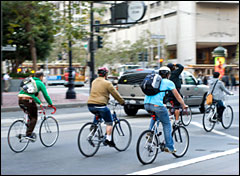Dear Umbra,
I bus, bike, or walk to work 98 percent of the time. I was wondering, when I’m biking (or walking, for that matter), am I inhaling more pollutants than those around me who are emitting them from their gas-guzzlers? Your answer won’t change my habits, since I’m not going to drive to work anytime soon — I’m just wondering if I’m the one paying the price for my enviro-friendly commuting? Thanks for your help!
Sara
Tucson, Ariz.
Dearest Sara,
What dedication. Even if biking is slowly filling your lungs with particulate silt, and a car is truly the capsule of protection that it seems, you will choose biking. For the Earth. Fortunately, though you are willing to sacrifice your health on the altar of environmentalism, biking is not worse than being inside the car.

Spare the ride, spoil the wild?
A car shell contains little gaps into which pollutants flow, and as a result, car occupants sit in a stew of carbon monoxide, benzene, and particulate matter, among other unpleasant vehicle emissions. Bicyclists, bus passengers, and pedestrians are all exposed to these emissions as well, but in a different way. I wrote about this dilemma a few years ago, and just reviewed some of the old and new literature. It seems that cyclists almost always encounter fewer pollutants with each breath than car passengers — that’s a special way to say that the foul mix of toxics is denser in the car than in the cycling zone. Cyclists are breathing more heavily than those sedentary drivers, as you know, so at the very worst their total exposure becomes the same as car passengers. At least that’s what I’ve managed to put together from the various studies. The bus and the sidewalk are, like the bicycle, on the edge of the toxic air zone; presumably riders and walkers are not breathing hard like a cyclist, and have lower total exposure.
It is ironic that as cyclists, pedestrians, and bus riders, we contribute to public health by reducing pollutants, while at the same time we share the same health hazards as those within automobiles.
A few variables in these studies are worth mentioning and considering for all kinds of transit. Just as you would guess, pollutants are lower on less-travelled routes and during less-travelled times of day. Pollutant concentrations are very influenced by the vehicle just in front of you, so it’s better not to follow, say, a diesel truck in poor condition. Pollutant levels are also lowest in the carpool lane — which doesn’t help cyclists, but does offer a bit of hope to drivers.
As I mentioned, I wrote about this topic a few years back, and I’m not averse to revisiting a topic even if no new data has arisen (Diapers! Diapers! Don’t forget to wear diapers while cycling!). In this case, I do have something new to say: Even sitting in a parked car may be toxic. There have been a few studies examining the offgassing toxins from new car interiors. One older Aussie study looked at new cars and found emissions of benzene, toluene, acetone, and other, unfamiliar -enes and -ones. In 2006, the Ecology Center, a Michigan nonprofit, found that the dust and windshield film of tested cars contained unsafe amounts of PBDEs (a type of flame retardant) and phthalates (plastics softeners). All these compounds are hazardous to our health, and our kids’ health.
To be fair, these studies did not study human uptake of these toxins, only their presence. Maybe they all magically flow out the windows. All the more reason to keep your car windows open.
And, of course, all the more reason to bike when we can.
Shiftily,
Umbra

